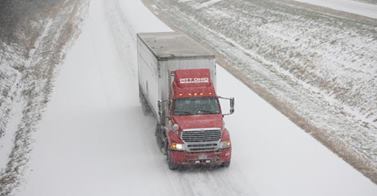Millions of over-the-road trucks fill U.S. highways on a daily basis. And depending on the season, driving conditions can vary drastically — from snow-covered roads to high-wind areas. During these dangerous and risky conditions, there are a few easy things you can do to increase your safety and ensure your cargo gets to its final destination in one piece.
1. Dealing With High Winds
Knowing how much weight is inside your trailer is especially important when you drive in high-wind conditions. The high profile of a box trailer makes it more susceptible to strong wind gusts, with a heavier load providing more stability when driving in windy conditions.
Keep in mind, though, that when driving in high winds, even with a heavy load, you should keep your load’s center of gravity low. And avoid driving with a light or no load in dangerously windy conditions. And remember to keep both hands on the wheel while driving to prevent a wind gust from wresting control of your truck out of your hands.
2. Staying Safe in the Rain and Fog
When driving in rainy or wet conditions, don’t forget about the risk of hydroplaning, which occurs when the tires of a vehicle momentarily lose traction and the vehicle slides across the roads surface. In wet and rainy conditions, slow down, allow for longer stopping distances, and turn on your headlights for better visibility.

In many sections of the country, rain is often accompanied by fog. Fog is created when warm air hits the surface of the cooled ground common after a rain storm. Remember to drive extra carefully in foggy conditions, including using your headlights, increasing your following distance, and slowing down.
3. Avoiding Hail and Lightning
Lightning and hail often accompany spring and summer thunderstorms. Because a hailstorm is usually brief, pull off the road and stop, making sure you angle your windshield away from potentially damaging hail until it passes.
Lightning tends to strike the highest object — potentially your truck or trailer. Your best bet during a lightning storm is to pull off the road and park in a safe area, such as a truck stop. And make sure to stay inside your truck if you stop in an open area.
4. Anticipating Tornadoes
Tornadoes present a real threat to truckers in many areas across the country. When driving in areas prone to tornadoes, make sure you know the difference between a watch and a warning. A watch means there is the possibility of a tornado in the area, while a warning means a tornado has been detected on the ground.
If you find yourself faced with the real prospect of a tornado, seek shelter in a nearby building. If shelter is not available, find a low-lying section of ground and lay flat with your hands over your head.
5. Driving in Snow
Ultimately, you will find yourself driving in snowy conditions. So, make sure you have chains onboard that you can use in an emergency. It’s important, though, that you know each state’s chain laws and have the right size chains for your truck. And keep a safety kit onboard that includes a flashlight, gloves, and reflective vest to aid you and keep you safe when putting chains on your tires.
In cold temperatures, make sure to treat your diesel fuel. This keeps the diesel in your tank from getting slushy. If you expect to encounter low temperatures, purchase anti-gel beforehand so you have it at the ready.
6. Using the Latest Apps
In addition to implementing safe-driving tips while driving in bad weather, you also can access a variety of useful weather apps to monitor real-time weather conditions. Some of the more popular apps come from The Weather Channel, Intellicast HD, and AccuWeather. All of these apps are free and are available for download on Android and iOs devices, and some on Windows phones.